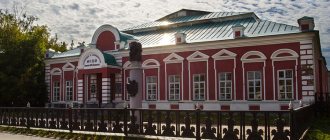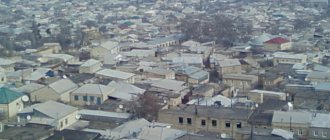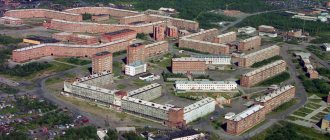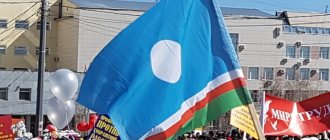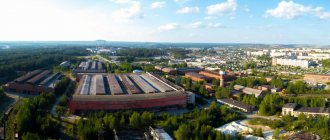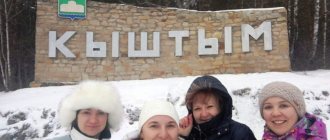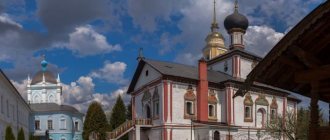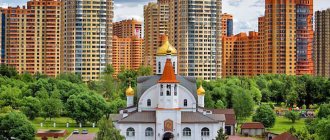Northern calm
Residents of Chukotka give the impression of being rather reserved, not too emotional people. Another interesting trait is slowness. And why rush if everything is nearby? And no one seems to care that, due to the strange boat schedule, you can spend a whole day taking a person to the airport. No one is freaking out, no one is in a hurry. Even the governor walks the streets.
On the right is Roman Kopin, governor of Chukotka.
Anastasia Koryagina, altapress.ru
15 thousand people live in Anadyr - the same number as the Chukchi in all of Russia. For every representative of the indigenous population there are two Russians. There are also mestizos. For many Chukchi, marriage with a representative of another nationality is considered a great success. The mixing of blood, in their opinion, heals the nation.
Previously, the Chukchi practiced group marriages and offered their wives for the night to visiting people of other nationalities in order to conceive a healthy and strong child. Now these customs have disappeared.
Life in Anadyr.
Anastasia Koryagina, altapress.ru
It is believed that there are no drug problems in Chukotka. To put it mildly, importing them is problematic, and hemp does not grow in permafrost conditions. In 2016, the last officially registered drug addict left the Autonomous Okrug.
But alcoholism is thriving. Alcohol in Anadyr can only be purchased until 8 pm, and on certain dates, for example, September 1 or Indigenous Peoples' Day, not at all. There are even villages in the region where the sale of alcohol is officially prohibited, and this was done at the request of the residents themselves. The indigenous population too quickly develops an addiction to alcohol.
Life in Anadyr.
Anastasia Koryagina, altapress.ru
Wikipedia says that Anadyr is located in the border zone, but this is no longer the case. It was removed in June 2022. Now the border zone covers only the islands. This means that now you can fly to Chukotka just like that, without obtaining a pass from the border guards in advance. Residents of Anadyr complain that because of this, the city is already flooded with foreigners and migrant workers.
Life in Anadyr.
Anastasia Koryagina, altapress.ru
Cultural recreation in the city of Anadyr
In the leisure centers of Anadyr, the culture of the peoples of the north intersects with modern trends. Thanks to this, tourists will be able to combine an inspiring program with entertainment.
House of Folk Art
- Address: st. Lenina, 23.
The Anadyr House of Folk Art is one of the best cultural centers in Chukotka. It was founded with the aim of developing children's and youth's talents, preserving folk art and popularizing culture among the younger generation.
Currently, at the House of Folk Art there are clubs for vocals, choreography, drama and drawing. The number of participants is 380 people.
On holidays, the House of Folk Art organizes concerts and performances, which are visited with interest by tourists. For them, this is an opportunity not only to have a good time and entertain the child, but also to listen to Chukchi folk chants, see ritual dances and performances based on northern fairy tales.
Trade and exhibition complex Novomariinsky
- Address: Otke street, 19.
Meetings of entrepreneurs and exporters are held at the Trade and Exhibition Complex. For tourists, this place becomes interesting on the days of big fairs. Entrepreneurs from different cities come here with their goods:
- fresh meat,
- berries and nuts,
- woolen products,
- objects of decorative and applied art.
Creative groups often perform at such fairs. It is also interesting to attend master classes on beading and wool felting.
Palace of Children and Youth Creativity
- Address: st. Mira, 6A.
Various areas of active recreation and art are being developed in the Children's and Youth Creativity Courtyard. Currently, the complex operates:
- ethno-ecological club “Einekey” is a unique creative formation dedicated to Chukchi songs, legends, and traditional crafts. Club members learn to fish in ancient ways, collect wild plants, and go on hikes. Particularly loved are gatherings with the elders of the camps and drinking tea with homemade flatbreads;
- volleyball section;
- swimming section;
- club "Moto-karting sport" - a children's driving school based on its own race track;
- the “Soft Toy” group, where children learn to sew and knit toys;
- chess Club;
- football section;
- art club “Watercolor”;
- "ROCK workshop".
This plus a large selection of developmental and health clubs for the little ones makes the Center for Children and Youth Creativity relevant for a child with any desires and needs.
Cinema "Polyarny"
- Address: st. Otke, 15.
The Polyarny Cinema is one of the most popular cultural and leisure centers in Anadyr. It is in great demand among children and youth. The new releases of Russian and foreign cinema are shown on the Polyarny screens. On premiere days, the building is filled with excitement. The complex includes a large auditorium, a snack shop and a small cafe.
Fishing place
The unemployment rate in Anadyr is low. There are all the administrative and social facilities that should be in the capital of any region. Coal, gold and silver are mined in the surrounding area. Reindeer husbandry, fishing and hunting are developed - this is mostly done by the indigenous population.
Life in Anadyr.
Anastasia Koryagina, altapress.ru
The main production in Anadyr is fish. Here you can buy the freshest chum salmon and caviar, because the fish is caught right within the city limits. The fish factory directly supplies products to the only supermarket in the city and other stores. In addition to salmon, smelt, pike, and whitefish are caught here.
Private traders catch fish with nets. Fishermen gut it right there on the shore, take out the caviar, salt it and pack it. They smoke it here, in the huts.
Fishing place in Anadyr.
Anastasia Koryagina, altapress.ru
Salmon are caught mainly for their caviar, because it can be sold profitably. Many fishermen, having caught a male, immediately throw him back into the sea. After gutting, females can be sold cheaply or given away for nothing. Or they throw it away, although this is prohibited.
It is also forbidden to exceed production standards, but most fishermen violate this prohibition. Poaching is common here, just on a different scale.
Life in Anadyr.
Anastasia Koryagina, altapress.ru
The Chukchi are an indigenous people, just like the Evens, Eskimos and Chuvans living in Chukotka. They can engage in fishing under special conditions, including catching Red List whales. Cunning Russian fish traders take advantage of this - they hire locals to work for themselves under the guise of ordinary fishermen.
Fishing place in Anadyr.
Anastasia Koryagina, altapress.ru
Government departments
System of government bodies The power of the district is determined by the Constitution of the Russian Federation and the Charter of the Chukotka Autonomous Okrug (1997). State power in the autonomous okrug is exercised by the governor of the Chukotka Autonomous Okrug - the highest official; The Duma of the Chukotka Autonomous Okrug is the legislator. (representative) state body authorities; The government of the Autonomous Okrug is the highest executive. state body authorities; other government bodies authorities formed in accordance with the Charter. The Duma is the highest and only legislative body. authorities. Consists of 15 deputies elected by the population of the Autonomous Okrug for a period of 5 years. At least 50% of Duma deputies are elected by a single electorate. district in proportion to the number of votes cast for the lists of candidates for deputies nominated by the elector. associations. The number of deputies working for prof. on a permanent basis, established by district law. In the Chukotka Autonomous Okrug there is a system of enforcement authorities. authorities headed by the government - the highest will execute. state body authorities of the Autonomous Okrug. The structure of the government and the procedure for its formation are established by the Charter. The governor of the autonomous district is elected for a term of 5 years by citizens living in the territory of the district. Elected qualifications and restrictions for candidates are established by federal law (2012).
White nights and cold summers
Anadyr has a harsh subarctic maritime climate. Summer is very short and cool. To a resident of the Altai Territory it may seem as if it doesn’t exist at all, and that it’s just spring smoothly flowing into autumn. On the warmest day of summer this year it was 22 degrees, on the coldest it was 2 degrees.
Weather in Anadyr.
Anastasia Koryagina, altapress.ru
In May-July the “white nights” begin here. The sun sets briefly behind the horizon, but it is still light outside all the time. You will not see the polar night, when there is no sun at all, in Anadyr. It just starts getting dark very early in winter, already at three o’clock in the afternoon. But in settlements located north of the capital, residents experience both the polar night and the polar day.
Weather in Chukotka.
Anastasia Koryagina, altapress.ru
Chukotka cannot be called a sunny region, but still there are more clear days here than in St. Petersburg. Due to its proximity to the sea, Anadyr has high humidity. In summer there is often fog, which dissipates only at 13-14 hours of the day.
The wind blows here all the time, and often cold. Local residents say that Anadyr stands on the seven winds. Because of this, even at +16 people wear jackets. Although there are “walruses” who change into shorts as soon as the sun comes out.
Life in Anadyr.
Anastasia Koryagina, altapress.ru
In winter, because of the wind, they say, sometimes the cold is unbearable. Some people use balaclavas. And in Chukotka there is the concept of “summer hat”.
Contrary to expectations, the northern lights are rare in Anadyr. In order to see this phenomenon in all its glory, it is better to go beyond the Arctic Circle, to the north.
Climate
The climate of the city is subarctic marine type, greatly influenced by monsoon winds, which are ensured by the change of the dominant masses - oceanic or continental. Unfavorable climatic conditions are observed here all year round: low temperatures and piercing winds. The coldest month is January. The average temperature this season is -24...-22 °C. It is worth noting that frosts are felt much sharper, as they are constantly accompanied by winds. In summer, the temperature rarely rises above +13 °C.
Precipitation is brought by air masses from the Pacific Ocean. The average annual precipitation is 200-300 mm, most of which occurs in the summer. It is this feature that ensures constant fog and cloudiness in the area.
“You can only get there by plane”
There is not a single railway or automobile station in all of Chukotka. Because there is no need. There are no railways, and well-maintained roads are built only within populated areas. Tourists mistake the treasury building for the station in Anadyr.
Right down the street is the treasury building in Anadyr.
Anastasia Koryagina, altapress.ru
Most of the settlements in Chukotka are isolated from each other. Near the regional centers there are usually one or two small villages, to which there are dirt roads. In winter, the road network is expanded due to the construction of winter roads.
For short distances, local residents drive SUVs, self-modified all-terrain vehicles (they are often found here) or dogs. In other cases, only by water or air.
Transport in Anadyr.
Anastasia Koryagina, altapress.ru
The Kapitan Sotnikov motor ship goes to some villages of the Chukotka Autonomous Okrug from July to September. He has a special schedule that is not always followed because the weather can be bad. Tickets cost from 4,400 to 7,700 rubles, and these are preferential rates, lower than the cost of transportation. Children under 14 years old can travel at 50% of the cost, and under 7 years old for free.
Intraregional air flights are served by the airline, which flies small An-type aircraft and Mi-8 helicopters. The cost of air tickets to the villages of Chukotka varies from 3 to 12 thousand rubles. All flight numbers begin with the letters AD, and tourists constantly make fun of this at the airport.
Transport in Anadyr.
Anastasia Koryagina, altapress.ru
Air tickets to Chukotka are among the most expensive in the country. For example, I had to fly through Moscow because it was cheaper. A ticket from the capital of the country to Anadyr cost 43 thousand rubles , and back - 28 thousand rubles.
Life in Anadyr, airport.
Anastasia Koryagina, altapress.ru
Capital of Chukotka
Anadyr is the largest settlement in the district and its administrative center. It is located on the shore of the Bering Sea estuary of the same name, where the Anadyr and Kazachka rivers flow into it. A little to the west of the city is Onemen Bay. Anadyr is located on a slight rise, its center is at an altitude of 35 meters above sea level. To the southwest of it stretch vast areas of flat tundra, occasionally covered with hills.
This is one of the most remote cities in the country. Local time differs from Moscow time by as much as nine hours. Geographically, the city is much closer to Alaska than to the capital of Russia (700 km to Nome, 6192 km to Moscow).
The area of Anadyr is only 20 square kilometers. It is built up with panel and block high-rise buildings. The appearance of the city is a little unusual. All his houses are colorful and resemble a toy town. This is how they cope with the pallor of local landscapes, because a small number of sunny days and the lack of bright colors around can cause a bad mood and even depression.
Mass media
News agency – “Chukotka”.
The largest periodical in the district is the newspaper “Far North” (Anadyr; since 1933; weekly, about 4 thousand copies, supplement in the Chukchi language).
Radio broadcasting since 1935, television since 1967. Broadcasting of television and radio programs is carried out by the Chukotka State Television and Radio Broadcasting Company.
There are few regional Internet media - regional branches of federal online publications and aggregators (TASS, Rambler, RIA, etc.) predominate; among the regional ones there is the portal “Chukotka - a beautiful and ... harsh land.”
Population
Russians make up 49.6% of the population, Chukchi - 25.3% (prevail in the Chukotka, Providensky, Iultinsky regions), Eskimos - 3% (in the east of the Chukotka, Providensky and Iultinsky regions), Evens - 2.8% (mainly . in Bilibinsky district - 11.1%), Chuvans - 1.8% (mainly in Anadyrsky district); Yukaghirs (0.4%), Koryaks (0.1%) and others also live (2010, census).
Demographic The situation is characterized by a severe reduction in population due to mass migration. outflow (main sample in the 1990s, maximum rate of over 860 per 10 thousand inhabitants in 1999): in 1990–2016 it decreased by more than 3 times. Until the beginning 2000s migrant the outflow was associated with unfavorable economic conditions. situation, in 2002 it was supplemented by a program for relocating residents to favorable climates. regarding areas. In the beginning. 2010s rate of migration losses have decreased, but still remain significant (117 per 10 thousand inhabitants, 2015). Natural is preserved. population growth (4.1 per 1000 inhabitants, 2015): birth rate 13.6 per 1000 inhabitants, mortality 9.5 per 1000 inhabitants. (9th place in the Russian Federation). Infant mortality is high (16.0 per 1000 live births; 85th place in the Russian Federation). The share of women is 49.0%; the population under working age (up to 16 years) is 22.8%, over working age – 13.2% (in the Russian Federation 24.6%). Wed. life expectancy is 64.2 years (84th place in the Russian Federation; men - 59.4, women - 69.7). Wed. density of us. 0.07 people/km2 (2016; the lowest in the Russian Federation). The majority of populated areas are concentrated around the sea. ports and located on the sea. coast. Share of mountains us. 69.2%. Large cities (thousand people): Anadyr (14.9), Bilibino (5.5), Pevek (4.7).
Education
In the district there are (data from Chukotstat, 2015): 15 preschool institutions (3725 pupils), 42 general education institutions. educational institutions (over 7 thousand students). Operating (2016): 3 secondary professional educational institutions. education, branches - St. Petersburg. state economical University, North-East. Federal University named after M.K. Ammosova, District Public Universal Library named after. V. G. Tan-Bogoraz (1947), Museum (created in 2002 by merging the District Museum of Local Lore and the Center for the Protection and Restoration of Historical and Cultural Monuments of the Ch. A. O.), Sector for the Integrated Development of Chukotka (history dates back to 1935, modern name and status since 2013) North-East. complex research institute of the Russian Academy of Sciences - all in Anadyr.
Links[edit]
Notes[edit]
- ^ abcdefg Law No. 33-OZ
- ^ abcdef Encyclopedia of Russian Cities
. Moscow: Great Russian Encyclopedia. 2003. p. 20. ISBN 5-7107-7399-9. - ^ ab Charter of Anadyr, Article 24
- Official website of the Anadyr urban district. Mayor Autobiography archived February 3, 2014, at the Wayback Machine (in Russian)
- Rosstat. » Regions of Russia. Basic socio-economic indicators of cities. 2012 ". Far Eastern Federal District. Cities of the Chukotka Autonomous Okrug.
- ^ a b Federal State Statistics Service (2011). “All-Russian Population Census 2010. Volume 1" [All-Russian Population Census 2010, vol. 1]. All-Russian Population Census 2010 [All-Russian Population Census 2010]
. Federal State Statistics Service. - https://habstat.gks.ru/wps/wcm/connect/rosstat_ts/habstat/resources/62f1a600408e9886a05deb4d45abe5e4/Number+of+population+of the+Chukchi+autonomous+okrug+by+municipal+entity+on+1+January+ .doc ; archived date: August 31, 2022; Archive URL: https://web.archive.org/web/20190831171236/https://habstat.gks.ru/wps/wcm/connect/rosstat_ts/habstat/resources/62f1a600408e9886a05deb4d45abe5e4/%D0%A7%D0%B8% D1%81% D0% BB% D0% B5% D0% BD% D0% BD% D0% BE% D1% 81% D1% 82% D1% 8C +% D0% BD% D0% B0% D1% 81% D0 % B5% D0% BB% D0% B5% D0% BD% D0% B8% D1% 8F +% D0% A7% D1% 83% D0% BA% D0% BE% D1% 82% D1% 81% D0% BA% D0% BE % D0% B3% D0% BE +% D0% B0% D0% B2% D1% 82% D0% BE% D0% BD% D0% BE% D0% BC% D0% BD% D0% BE % D0% B3% D0 % BE +% D0% BE% D0% BA% D1% 80% D1% 83% D0% B3% D0% B0 +% D0% BF% D0% BE +% D0% BC% D1% 83% D0% BD% D0% B8% D1% 86% D0% B8% D0% BF% D0% B0% D0% BB% D1% 8C% D0% BD% D1% 8B% D0% BC +% D0% BE % D0% B1% D1% 80% D0% B0% D0% B7% D0% BE% D0% B2% D0% B0% D0% BD% D0% B8% D1% 8F% D0% BC +% D0% BD% D0% B0 + 1 +% D1% 8F% D0% BD% D0% B2% D0% B0% D1% 80% D1% 8F + 2018 +% D0% B3% D0% BE% D0% B4% D0% B0. doc.
- ^ abc Law No. 40-OZ
- Law No. 148-OZ
- "On the Calculation of Time". Official Internet portal of legal information
. June 3, 2011. Retrieved January 19, 2022. - Post office. Information and computing center of OASU RPO. ( Post office
).
Search for postal service objects ( postal Search for objects
) (in Russian) - ^ abcdef Petit Futé, Chukotka
, pp. 77ff - ^ ab Armstrong, page 53
- ^ abcdefghijk Gray, pp. 88–90
- Zhikarev, pp. 60-61
- Zhikarev, p. 63
- ↑
Dikov, s. 148 - ↑
Dikov, s. 156 - Dikov, p.151-152
- Krusdanov, s. 111
- Lebedev, Igor Aviation Lend-Lease in Russia
Nova Publishers (1997) pp.44-49 - ^ ab Estimates of Soviet Surface-to-Surface Missile Deployment, November 1965, Guided Missile and Space Intelligence Committee, Central Intelligence Agency, Washington, DC.
- Armstrong, page 187
- Gray, page 135
- https://www.newscientist.com/article/mg22329860.300-quasicrystal-quest-the-unreal-rock-that-nature-made.html#.VQoRbdFOVUY
- ^ ab Gray, page 122
- Directive No. 517-rp
- List of settlements in the Far Eastern Territory. Based on materials from the All-Union Population Census of December 17, 1926 and the Subpolar Census of 1926-27. — Khabarovsk; Blagoveshchensk, 1929
- RGAE, f. 1562, op. 336, d. 1470, l. 20.
- Census Population of the USSR 1959 archived July 19, 2011 at the Wayback Machine
- 1970 USSR Population Census Archived March 23, 2012, in the Wayback Machine
- 1979 USSR Population Census Archived March 23, 2012, in the Wayback Machine
- “All-Union Population Census of 1989. The current population of union and autonomous republics, autonomous regions and districts, territories, negative phenomena, urban settlements and rural district centers” [All-Union Population Census of 1989: current population of union and autonomous republics, Autonomous regions and districts , territories, regions, districts, towns and villages performing the functions of district administrative centers. All-Union Population Census of 1989 [All-Union Population Census of 1989]
.
Institute of Demography of the National Research University: Higher School of Economics [Institute of Demography of the National Research University: Higher School of Economics]. 1989 - via Demoscope Weekly
. - ↑
Federal State Statistics Service of Russia (May 21, 2004).
“The population of Russia, the constituent entities of the Russian Federation as part of federal districts, urban settlements, settlements, settlements of 3 thousand or more people” [Population of Russia, its federal districts, federal districts, districts, urban settlements, rural settlements - administrative centers and rural settlements with a population of more than 3,000 people] (XLS). All-Russian Population Census 2002
. - ^ ab Gray, page 126
- Gray, page 118
- ^
A project has been developed for the construction of a road from Kolyma to Anadyr. - "Weather and climate - climate of Anadyr". Weather and climate (Weather and climate). Retrieved May 13, 2015.
- "Climatic norms of Anadyr 1961–1990". National Oceanic and Atmospheric Administration. Retrieved May 13, 2015.
- (PDF). August 12, 2011 https://web.archive.org/web/20110812094031/https://bethel.govoffice.com/vertical/Sites/%7B86032ACB-92B0-4505-919A-3F45B84FECD9%7D/uploads/%7BEFEDEA86 - 3466-4370-A7D0-E88B43BA40CF% 7D.PDF . Archived from the original (PDF) on August 12, 2011. Retrieved April 18, 2022. Missing or empty |title=( help )
Sources [edit]
- Duma of the Chukotka Autonomous Okrug. Law No. 33-OZ of June 30, 1998 “On the administrative-territorial structure of the Chukotka Autonomous Okrug,” as amended. Law No. 55-OZ of June 9, 2012 “On amendments to the Law of the Chukotka Autonomous Okrug” On the administrative-territorial structure of the Chukotka Autonomous Okrug “”. Came into force ten days from the date of its publication. Published: “Vedomosti”, No. 7 (28), May 14, 1999 (Duma of the Chukotka Autonomous Okrug. Law of June 30, 1998 No. 33-OZ “ On the administrative-territorial structure of the Chukotka Autonomous Okrug”
as amended by the Law of June 9, 2012 No. 55-OZ “
On Amendments to the Law of the Chukotka Autonomous Okrug”).
"On the administrative-territorial structure of the Chukotka Autonomous Okrug" . Valid after ten days from the date of official publication.). - Government of the Chukotka Autonomous Okrug. Order No. 517-rp dated December 30, 2008 “On approval of the register of administrative-territorial and territorial entities of the Chukotka Autonomous Okrug,” as amended. Order No. 323-rp dated June 27, 2011 “On amendments to the Order of the Government of the Chukotka Autonomous Okrug dated December 30, 2008 No. 517-rp.” Published: Database “Consultant-plus”. (Government of the Chukotka Autonomous Okrug. Order No. 517-rp dated December 30, 2008 “ On approval of the Register of administrative-territorial entities of the Chukotka Autonomous Okrug”
as amended by order No. 323-rp dated June 27, 2011
On amending the Decree of the Government of the Chukotka Autonomous Okrug District dated December 30, 2008 No. 517-rp
. - Duma of the Chukotka Autonomous Okrug. Law No. 40-OZ of November 29, 2004 “On the status and boundaries of the municipal formation of the city of Anadyr, Chukotka Autonomous Okrug.” Came into force ten days from the date of official publication. Published: “Vedomosti”, No. 31 / 1 (178/1), December 10, 2004 (Duma of the Chukotka Autonomous Okrug. Law No. 40-OZ of November 29, 2004 “ On the status and boundaries of the municipal formation of the city of Anadyr, Chukotka Autonomous Okrug
Comes into force on the day following ten days after the date of official publication.) - Duma of the Chukotka Autonomous Okrug. Law No. 148-OZ of November 24, 2008 “On the status, borders and administrative centers of municipalities on the territory of the Anadyr municipal district of the Chukotka Autonomous Okrug,” as amended. Law No. 24-OZ of April 1, 2011 “On amendments to Appendix 2 to the Law of the Chukotka Autonomous Okrug” On the status, boundaries and administrative centers of municipalities in the territory of the Anadyr municipal district of the Chukotka Autonomous Okrug “”. Came into force ten days from the date of official publication. Published: “Vedomosti”, No. 46 / 1 (373/1), November 28, 2008 (Duma of the Chukotka Autonomous Okrug. Law of November 24, 2008 No. 148-OZ). On the status, borders and administrative centers of municipalities on the territory of the Anadyr municipal district of the Chukotka Autonomous Okrug
as amended by the Law of April 1, 2011 No. 24-OZ “
On amendments to Appendix 2 of the Law of the Chukotka Autonomous Okrug” “On the status, borders and administrative centers municipalities on the territory of the Anadyr municipal district of the Chukotka Autonomous Okrug"
. Valid from the day that occurs ten days after the official date of publication.). - Council of Deputies of the Anadyr Urban District. Decision No. 175 of December 8, 2010 “On approval of the new edition of the charter of the Anadyr urban district,” as amended. Decision No. 360 of May 30, 2013 “On amendments to the Charter of the Anadyr Urban District.” Came into force after official publication. Published: “Vedomosti”, No. 51 (481), December 31, 2010 (Council of Deputies of the Anadyr Urban District. Decision No. 175 of December 8, 2010 “ On approval of the Charter of the Anadyr Urban District in a new edition”
as amended by Decision dated 30 May 2013 No. 360 “
On Amendments”).
Charter of the Anadyr urban district ( comes into force after official publication). - T. Armstrong. Russian Settlement in the North
(1965) Cambridge University Press. - N. N. Dikov (N. N. Dikov). “History of Chukotka from ancient times to the present day” ( History of Chukotka from ancient
times to the present day) (1989) Moscow. - P.A. Gray. The State of the Indigenous Peoples of Chukotka: Post-Soviet Activism in the Russian Far North (2005) Cambridge University Press
- N. A. Zhikarev (N. A. Zhikarev). Essays on the History of the North-East RSFSR ( Essays on the History of the North-East RSFSR
) (1961) Magadan. - A.I. Krusdanov (A.I. Krusdanov). "Soviets in the North-East of the USSR (1962–1982): Collection of documents and materials, part 3" ( Soviets of the North-East USSR (1962–1982): Collection of documents and materials, part 3
) (1986) Magadan
Nature
The shores of the East Siberian and Chukchi seas are slightly indented, with large bays - Chaunskaya and Kolyuchinskaya bays; there are numerous lagoons (Amguema, Vankarem, etc.). In the Bering Sea - Anadyrsky Hall. with the bays of the Cross, Onemen, the Anadyr Estuary, as well as fjords (Lavrentia Bay, Providence Bay).
Relief
Providence Bay. Photo by A.I. Nagaeva
2/3 of the territory is occupied by mountains and highlands (the predominant heights are approximately 1000 m). In the south west parts are represented by the Ush-Urekchen ridges (up to 1685 m) and Oloisky (up to 1816 m). To the north of them are the Anyui Range (up to 1779 m high) and the Anyui Highlands. The Chukotka Plateau extends in the northeast (altitudes up to 1887 m in the Chantal Range - the highest in the Black Sea region). Center. part is occupied by the Anadyr Plateau and the Pekulney ridge (up to 1362 m high, Mount Obzornaya). In the east there is the Genkany ridge (up to 978 m high), in the south there is the north. part of the Koryak Highlands. Many ridges are characterized by glacial landforms: cirques, jagged ridges, through valleys. In some places, traces of ancient glaciation and cones of extinct volcanoes (Anyuyskoye Highlands) have been preserved. Less than 1/3 of the territory is occupied by lowlands: Anadyr Lowland, Parapolsko-Belskaya, Chaunskaya, Anyuiskaya, Vankaremskaya, etc.
Geological structure and minerals
Within Ch. a. O. allocate east. part of the Late Mesozoic Verkhoyansk-Chukotka folded region, northern. parts of the Okhotsk-Chukotka volcanoplutonic belt and the Late Mesozoic-Cenozoic Koryak-Kamchatka folded region. In the Verkhoyansk-Chukotka region, the South Anyui suture zone divides the eastern. part of the Verkhoyansk-Kolyma system (northern margin of the Kolyma-Omolon microcontinent with a pre-Riphean basement and the Late Paleozoic-Mesozoic island-arc terrane) and the New Siberian-Chukchi system (Paleozoic and Mesozoic terrigenous-carbonate deposits of the passive margin of the Chukotka-Alaska microcontinent, the Precambrian basement of which extends to surface in eastern part of the Chukotka Peninsula). The South Anyui zone (terrigenous rocks of the Triassic, Upper Jurassic and Lower Cretaceous; Paleozoic and Early Mesozoic ophiolites; island-arc volcanics of the Late Mesozoic and Early Cretaceous granites) arose on the site of the ancient oceanic. basin, which closed at the end of the Jurassic - the beginning of the Cretaceous. The superimposed Okhotsk-Chukotka belt is formed by Cretaceous volcanics. North part of the Koryak-Kamchatka region is composed of oceanic. and island-arc complexes of the Paleozoic, Mesozoic and Paleogene; intramountain and intermountain depressions and troughs (Anadyr, Khatyrsky, etc.) are filled with Neogene-Quaternary sediments (often coal-bearing). To the southeast Late Cenozoic volcanism occurred in parts of the Chukotka Peninsula.
Nedra Ch. a. O. rich in gold (primary deposits with large reserves - gold-arsenic-sulfide Mayskoye, gold-silver Kupol and Dvoinoye, gold-copper-porphyry Peschanka; with moderate reserves - gold-quartz Karalveemskoye and Kekura; several hundred placer deposits of the Chukotka gold-bearing region), tin ores (stockwork tungsten-containing deposits of the Pyrkakai ore cluster with total tin reserves amounting to 11% of all-Russian reserves), mercury (West-Palyanskoye, Tamvatneyskoye and other deposits of the largest Chukotka mercury province). There are deposits of coal (Anadyrskoye, Ugolnaya Bay), oil, gas and gas condensate (belonging to the Bering Sea basins - Anadyrskoye and Khatyrskoye). The shelves of the East Siberian and Chukchi seas are promising for oil and gas. There are known deposits of copper ores, molybdenum, platinum group metals (mainly alluvial), and raw materials for the production of building materials.
Climate
Coastal northern The areas are located in the Arctic marine climate. belts Characterized by long frosty winters, short cool summers with drizzling rains and frequent frosts. Wed. temperature in February (the coldest month) from –21.7 °C (meteorological station Uelen) to –24.6 °C (Koluchino), absolute minimum –48 °C. Snowfalls are heavy, the number of days with snow is 244–248, with blizzards – 56–74 (from December to March they can last 10–15 days in a row). Wed. wind speed 8–15 m/s, max. 35–40 m/s. The number of days without sun (polar night) is up to 193 (Uelen). In the coastal regions of the Bering Sea, the climate is marine subarctic; Wed January temperatures range from –15.9 °C (Provideniya Bay) to –19.3 °C (Laurentia Bay). At Cape Navarin, max. wind speeds, the highest frequency of hurricanes, storms, blizzards. In continental regions the climate is sharply continental; Wed January temperatures from –26.2 °C (Ust-Belaya) to –39.2 °C (Omolon), absolute minimum –61 °C. The thickness of the snow cover is up to 60–70 cm. There is avalanche danger in the mountains.
Summer is short and cloudy weather prevails. Wed. August temperature in the north. coast 5.4 °C (Uelen), on the Bering coast 4.5 °C (Chaplino), to the south (on the coast of Anadyr Bay) from 7 °C (Sireniki) to 10 °C (Anadyr), absolute maximum 28 °C; in continental areas 13.6 °C (Markovo), absolute maximum 33 °C. The greatest amount of precipitation falls on the coast of the Bering Sea - 580 mm per year (Lavrentia Bay), in Anadyr 330–340 mm, in continental regions 200 mm. Vegetarian period from 75 days (Pevek) to 100 days (Markovo), on the island. Wrangel - less than 40 days.
On the ridges of Chantalsky, Iskaten, Pekulney, and the Providence massif, modern civilization is developed. glaciation (21 glaciers with a total area of 13.5 km2). Permafrost rocks (thickness 300–400 m) are ubiquitous; on the coast and near thermal springs there is insular permafrost. Under the beds of large rivers there are talik zones (for example, Markovskaya on the Anadyr River, which is 15–20 km across).
Inland waters
The rivers belong to the basins of the Arctic and Pacific oceans. The largest of them are Anadyr (with tributaries Belaya, Main), Velikaya, Kanchalan (Pacific basin), Amguema, Pegtymel, Rauchua, as well as tributaries of the river. Kolyma - Omolon (with tributaries Oloy, Kurya), Bolshoy Anyui, Maly Anyui (Northern Arctic basin). The rivers are fed by snow and rain. Freeze-over lasts 7–8 months or more. Characterized by uneven flow, high floods, ice jams, and freezing of many watercourses to the bottom. On mountain rivers there are rifts and rapids. Large lakes: Krasnoe, Elgygytgyn (crater, 169 m deep), Pekulneyskoye, Koinygytgyn, Mainits, etc. There are many thermokarst lakes. Total area lakes 58.3 thousand km2. In the coastal zone there are lagoons with salt and fresh (flowing) water. There are 5 reservoirs (Pevekskoye, Kazachinskoye, etc.).
Soils, flora and fauna
2/3 pl. The districts are occupied by tundra. On the islands and coast of the Arctic approx. stretches a narrow strip of arctic. tundra with rare moss-lichen polygonal groups on arctic-tundra soils in combination with swamps in depressions and small areas of coastal saline meadows on arctic marsh saline soils. On the sea terraces there are clumps of low-growing willows, wild rosemary, partridge grass, cotton grass, polar poppy, etc. To the south, in the Anadyr and Parapolsko-Belsk lowlands, hypoarctic typical (shrub-moss-lichen with an abundance of blueberries, lingonberries, crowberries) and shrubby (bush, alder, willow) tundra on tundra-gley soils in combination with hummock tundra and swamps on peat-bog soils. In well-drained areas there are large-shrub tundras with dwarf cedar. Lichen and hummock tundras are used for reindeer pastures. In the valleys of the Anadyr and Main rivers, forests of fragrant poplar, choicenia with the participation of Sakhalin willow, and Kayander larch are represented on taliks.
The lower belt of the mountains is occupied by large shrub groups of dwarf cedar, alder with a moss-lichen cover, and in some places larch forests on dry-peaty lithozems. Steppe forests appear on the solar slopes (Lena fescue, foot-shaped sedge, Arctic Siberian wormwood, etc.). Higher up the slopes there are shrub-lichen and lichen tundras, from the heights. 800–1000 m – rocky semi-deserts and deserts with an abundance of snowfields. In the west (in the Omolon basin) there are sparse larch forests (Cajander larch) with an undergrowth of dwarf cedar, and in some places dwarf birch on podburs or on taiga gley soils. Forest cover ranges from 7 to 17%. In Ch. a. O. there are 900 species of vascular plants, 400 species of mosses and lichens. OK. 50% of the district's territory is used for pasture.
The fauna is diverse - from arctic-tundra to northern taiga species (64 species of mammals, 220 species of birds, many of which are included in the Red Book of the Black Sea region). Here there are large rookeries of the Pacific walrus, 6 species of whales live, the only habitat of the Chukchi bighorn sheep and the world's largest colony of white goose (20-30 thousand pairs on Wrangel Island), which means. spawning grounds of Pacific salmon, the largest number of polar bear “maternity” dens in the world (Wrangel Island). On the coastal rocks there are bird colonies (particulate puffins, puffins, mottled puffins, buzzards, gulls, etc.). There are tundra partridge, rarely - the endemic and relict pink gull, common white goose, lemming, arctic fox, bighorn sheep, wolf, mountain hare, white and brown bears, reindeer, in the forests - sable, ermine, lynx, etc. In the rivers and lakes - nelma, grayling, whitefish, whitefish, burbot, dalliya, etc. In the seas - chum salmon, pink salmon, 4 species of crabs, 4 species of shrimp and more than 20 species of mammals: whales, seals, walruses, killer whales, sea lions, sea otters, etc. d. On the island. Wrangel musk oxen are acclimatized. The Red Book of the Russian Federation includes the polar bear, bighorn sheep, marine mammals (narwhal, fin whale, sei whale, humpback whale, gray and blue whale, minke whale) and 24 species of birds (pink gull, etc.).
Condition and protection of the environment
Ecological the situation is relatively favorable among the regions of the Far East, except for areas of mineral development, which lead to disturbance of land, soil and vegetation cover, and pollution of watercourses. The total volume of emissions of pollutants into the atmosphere is 22.3 thousand tons, including from stationary sources - 17.8 thousand tons, from road transport - 4.5 thousand tons (2014). Water intake from natural water sources is 26.5 million m3, wastewater discharge into surface water bodies is 22.6 million m3, of which 4.9 million m3 is polluted (2014). Local pollution of coastal waters occurs (Ugolnaya Bay, Anadyrsky Estuary near Anadyr, etc.). Rivers are most polluted in areas where placer gold is mined. There is a problem of shortage of drinking water everywhere, especially in coastal areas. Accumulated approx. 1 million units of barrel containers with residual fuels and lubricants. The passage of all-terrain vehicles leads to land disturbance, especially pastures (every 100 km of their route destroys more than 1 hectare of reindeer pastures). Floods lead to dangerous situations; The city of Anadyr and a number of villages are flooded. Fires cause great damage, reducing the area of pastures and, accordingly, the number of deer (up to 158,500 animals in 2015), the nature of forests is changing, the area of burnt areas is increasing, and the number of sable and elk is decreasing.
Protected natural areas occupy 4.8% of the area, among them - the Wrangel Island reserve, national. Berengia Park, Chaunskaya Bay, Avtatkuul (Avtatkuul), Ust-Tanyurersky, Lebediny, Lake Elgygytgyn nature reserves, 20 natural monuments (Anyuysky volcano, Pegtymelsky, etc.).
Music
The basis of music. cultures - folklore of Russians, Chukchi, Eskimos, Ukrainians, Evens, Evenks, Chuvans and other peoples. Among the song and dance folklore groups: “Chukchi Dawns” (founded in the early 1960s, Khatyrka village), choir “Markovskie Vecherki” (1952, Markovo village; Russian, Cossack songs; both in the Anadyr region -not), “Lorinsky Dawns” (1969, village of Lorino, Chukotka region, since 1975 people’s collective), “Above Anyuem” (founded in 1960 on the basis of the red yaranga), “Temrik” (1999, village of Keperveem; both are in Bilibinsky district). In 1957–58, the district People's House was opened in Anadyr. creativity (later repeatedly reorganized and renamed, since 2013 House of Folk Art in the Anadyr region), coordinating work to preserve traditions. adv. culture, on the basis of which district holidays and festivals are held. Under him, the State was founded in 1968. Chukchi-Eskimo ensemble "Ergyron" (Chukchi. "Dawn"; state status since 1974) - the only prof. collective, in 2000 it was recognized as a particularly valuable object of cultural heritage of the peoples of Ch. O. At the People's House creative work also includes the Eskimo folk ensemble “Atasikun” (Eskimo “All Together”; 1986, since 1990 people’s group), people’s group. collective “Folk Song Theater “Karavai”” (2006; repertoire includes Russian songs from different regions of the country). Ensembles perform at numerous venues. festivals, including the district folklore festival "Ergav" (Chukotka. "Glory"; since 1990), which takes place 1-2 times a year (was not held in 1995-99) in Anadyr and the settlements of the Bilibino, Anadyr, and Chukotka regions.
Healthcare
In Ch. a. O. per 10 thousand inhabitants accounts for 71.3 doctors, persons avg. honey. personnel – 147, hospital beds – 149 (2013). The structure of the general morbidity of the population is dominated by respiratory diseases, cardiovascular diseases, injuries and poisoning (2013). The incidence of tuberculosis is 137.5 cases per 100 thousand inhabitants. (2013). Basic causes of death: cardiovascular diseases (40%), injuries and poisoning (21%), malignancies. neoplasms (10.9%), other diseases (12.6%).

